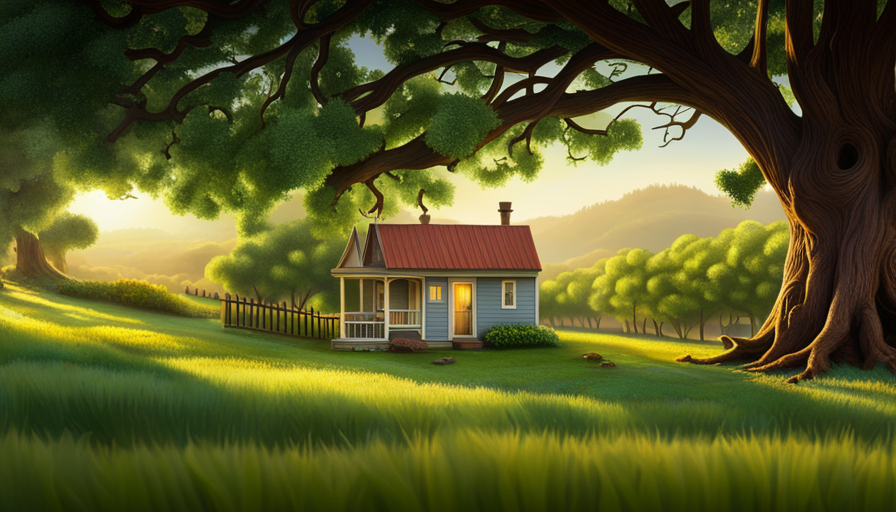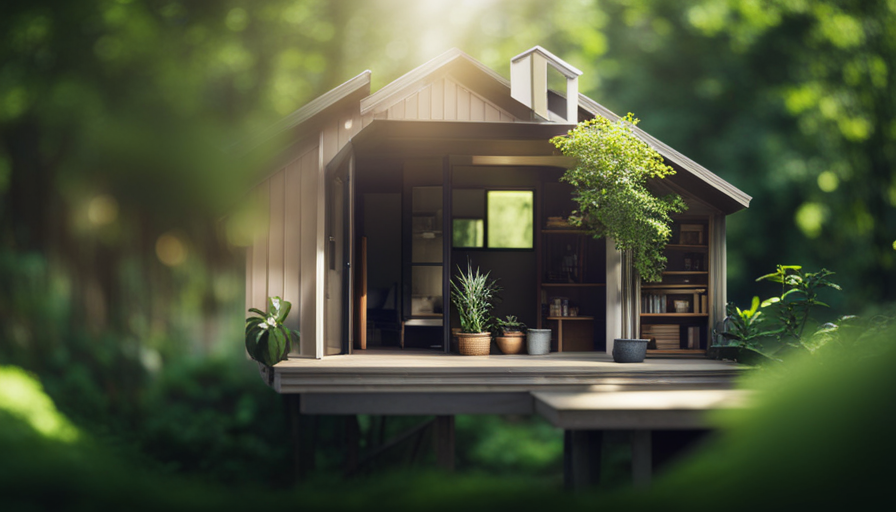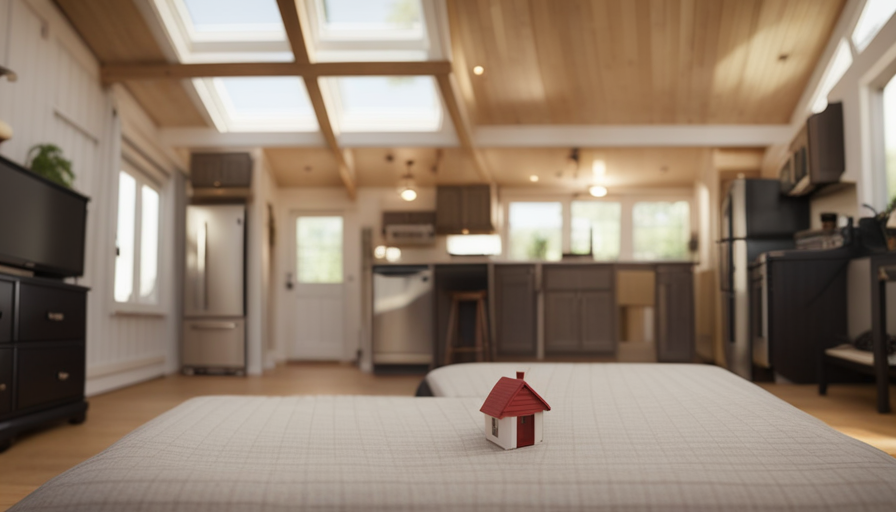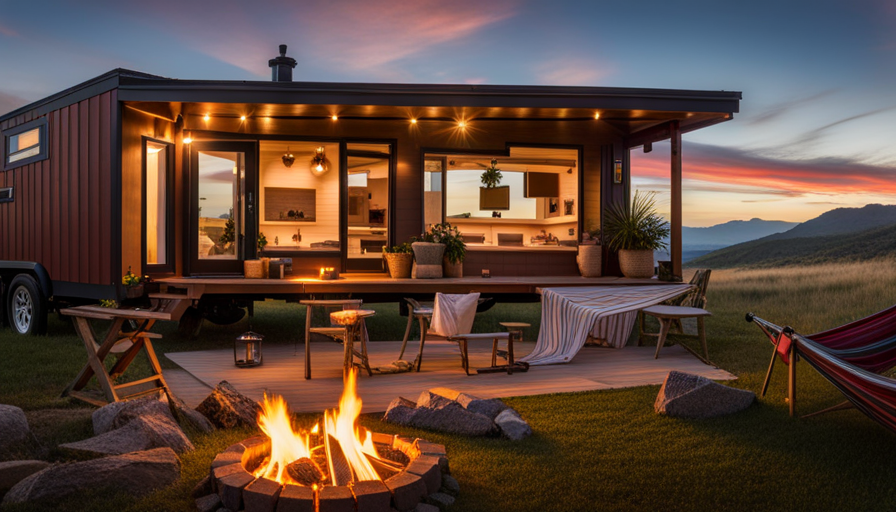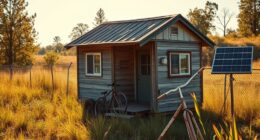Did you know that in the past 50 years, the average size of homes in the United States has tripled? This increase not only results in higher expenses, but also leads to more maintenance and a greater impact on the environment. As a result, many people are choosing tiny homes as a more environmentally friendly and affordable housing option.
But when it comes to parking your tiny house on someone’s land, how big is too big? In this article, I will provide you with the information you need to navigate local zoning and building codes, seek permission from the landowner, and consider off-grid options.
We will also discuss the size and dimensions of your tiny house, as well as any community and homeowner’s association rules to be aware of. So if you’re dreaming of downsizing and joining the tiny house movement, read on to find out how to park your tiny house on someone’s land legally and responsibly.
Key Takeaways
- Understanding local zoning and building codes is crucial when parking a tiny house on someone’s land.
- Consult with a legal professional specializing in real estate and zoning laws to ensure compliance with local regulations.
- Thorough research and legal advice are necessary to navigate potential legal hurdles and avoid turning a tiny house dream into a legal nightmare.
- Explore alternative parking options such as RV parks, campgrounds, and homeowner associations to increase the chances of finding a suitable spot for a tiny house.
Understand Local Zoning and Building Codes
Wondering if you can park a tiny house on someone’s land? Let’s dive into understanding local zoning and building codes!
When it comes to placing a tiny house on someone else’s property, it’s important to understand local restrictions and regulations. Each area has its own zoning laws that dictate what can be built and where. Researching building permits is crucial to ensure compliance with these regulations.
Some areas may have specific requirements for tiny houses, such as size limitations or foundation specifications. By understanding these rules, you can determine if your tiny house is eligible to be parked on someone’s land.
Once you have a clear understanding of the local zoning and building codes, you can move on to the next step: seeking permission from the landowner.
Seek Permission from the Landowner
When seeking permission from a landowner to park a tiny house on their property, it’s essential to effectively communicate and negotiate with them.
This involves discussing the terms and agreements for the arrangement. By engaging in open and transparent conversations, both parties can establish a mutual understanding of expectations, responsibilities, and any financial arrangements that may be involved.
Communicate and Negotiate with the Landowner
To successfully negotiate with the landowner, you’ll need to clearly communicate your intentions and demonstrate how a tiny house can be a valuable addition to their property. Start by discussing the possibility of obtaining the necessary building permits and any required lease agreements.
Make sure to highlight the benefits that a tiny house can bring, such as increased property value, potential rental income, and the ability to provide affordable housing solutions. Show them examples of successful tiny house installations and provide information on the minimal impact it will have on their land.
Once you have established the value and feasibility of having a tiny house on their property, transition into discussing the specific terms and agreements that will need to be addressed.
Discuss Terms and Agreements
Once you’ve highlighted the benefits and feasibility of having a tiny house on their property, it’s time to delve into the nitty-gritty details of discussing terms and agreements. This step is crucial to ensure a smooth and mutually beneficial arrangement with the landowner. It is important to clearly outline the terms and conditions of the agreement, including the length of stay, rent or compensation, utilities, and any other relevant factors. To help you navigate this process, consider using a table like the one below:
| Terms and Conditions | Legal Implications |
|---|---|
| Length of Stay | Zoning restrictions |
| Rent/Compensation | Property tax |
| Utilities | Liability |
| Maintenance | Insurance |
By discussing these terms and agreements, you can ensure that both parties are on the same page and avoid any misunderstandings or conflicts down the line. In the next section, we will explore the possibility of considering off-grid options for your tiny house.
Consider Off-Grid Options
Although it may be tempting to rely on traditional utilities, exploring off-grid options can open up a world of possibilities for parking a tiny house on someone’s land. It’s like a symphony of self-sufficiency. Off-grid living offers a sustainable approach that minimizes the environmental impact and reduces reliance on external resources. By incorporating renewable energy sources such as solar panels or wind turbines, you can generate your own electricity. This ensures a constant power supply for your tiny house. Additionally, implementing rainwater harvesting systems and composting toilets can help minimize water usage and waste management. These off-grid options not only provide a sense of independence but also allow for a more sustainable and eco-friendly lifestyle. Assessing the size and dimensions of your tiny house is the next crucial step in determining the perfect fit for parking on someone’s land.
Assess the Size and Dimensions of Your Tiny House
When assessing the size and dimensions of my tiny house, it’s crucial to measure its length, width, and height accurately. This will ensure that I have a clear understanding of the space available and can plan accordingly.
Additionally, it’s essential to determine if my tiny house meets the legal requirements in terms of size and dimensions. This will impact where I can park it and any potential restrictions I may face.
Measure Your Tiny House’s Length, Width, and Height
To determine how big of a tiny house you can park on someone’s land, you need to measure its length, width, and height. Understanding the regulations and finding a suitable location are essential steps in this process.
Regulations vary from place to place, so it’s crucial to research and comprehend the specific guidelines in your area. Once you have a clear understanding of the regulations, you can measure your tiny house.
Start by measuring the length from the front to the back, then measure the width from side to side, and finally, measure the height from the ground to the highest point. By accurately measuring your tiny house, you can determine if it meets the legal requirements for parking on someone’s land.
Determine if Your Tiny House Meets Legal Requirements
Now that we’ve measured our tiny house, it’s time to determine if it meets the legal requirements for parking on someone’s land. It’s important to familiarize ourselves with the local regulations and parking restrictions in the area where we plan to park our tiny house.
Each jurisdiction may have different rules regarding the size, location, and zoning requirements for tiny houses. By understanding these regulations, we can ensure that our tiny house is compliant and avoid any potential legal issues.
Additionally, some areas may have specific parking restrictions that limit where and how long a tiny house can be parked on someone’s land. Being aware of these restrictions will help us find suitable parking options.
Next, we’ll consider community and homeowner’s association rules to ensure that our tiny house aligns with their guidelines and regulations.
Consider Community and Homeowner’s Association Rules
Remember that homeowner’s associations may have specific rules regarding the size of tiny houses that can be parked on someone’s land, so it’s important to check those regulations beforehand.
It’s worth noting that according to a survey by the American Tiny House Association, around 63% of tiny house communities have restrictions on the maximum size of homes allowed, with many capping it at 400 square feet. These community guidelines are put in place to maintain a certain aesthetic and ensure that the tiny house lifestyle is preserved.
Additionally, homeowner’s association regulations may also address other aspects such as exterior design, height restrictions, and even the type of materials used. To navigate through these requirements, it is advisable to consult with a legal professional who specializes in real estate and zoning laws to ensure compliance and avoid any potential issues in the future.
Consult with a Legal Professional
When considering the legal aspects of parking a tiny house on someone’s land, it’s crucial to seek advice and guidance from a legal professional. They can provide valuable insights into the specific laws and regulations that govern your area and help ensure compliance.
By consulting with a legal professional, you can navigate through any potential legal hurdles and make informed decisions regarding the size of the tiny house you can park on someone’s land.
Seek Legal Advice and Guidance
Seeking legal advice and guidance is crucial when determining the maximum size of a tiny house that can be parked on someone’s land. It is important to consult with a legal professional who specializes in zoning and land use regulations to ensure compliance with local laws.
When considering the size of a tiny house, there are financial implications and insurance requirements to take into account. A legal expert can provide valuable insights into these matters, helping you understand the potential costs and necessary coverage for your tiny house. They can also advise you on any restrictions or permits that may be required, ensuring that you’re in compliance with local regulations.
By seeking legal advice, you can navigate through the legal complexities and make informed decisions about the size of your tiny house while adhering to the law.
Ensure Compliance with Local Laws
Don’t risk turning your dream of a cozy, mobile retreat into a legal nightmare – make sure you’re playing by the rules and staying in the good graces of the local authorities. Understanding local regulations is crucial when parking a tiny house on someone’s land.
Each locality has its own set of rules and restrictions regarding housing structures, zoning, and land use. Navigating these legal obstacles requires thorough research and possibly seeking legal advice. Some areas may have minimum square footage requirements, restrictions on parking mobile dwellings, or even specific permits needed for tiny houses.
By familiarizing yourself with the local laws, you can ensure compliance and avoid any potential penalties or disputes. Once you understand the regulations, you can confidently research alternative parking options for your tiny house.
Research Alternative Parking Options
Consider exploring alternative parking options to find the perfect spot for your tiny house on someone’s land. When it comes to finding suitable parking locations, it’s important to do your research and ensure you’re complying with local laws.
However, there may be instances where traditional parking options are limited or not available. In such cases, exploring temporary parking options can be a great solution. Here are a few alternative parking options to consider:
-
RV Parks: Many RV parks offer designated spaces for tiny houses. These parks often have amenities like water, electricity, and sewage hookups, making them a convenient choice.
-
Campgrounds: If you’re looking for a more natural setting, campgrounds can provide a scenic and temporary parking option. Keep in mind that some campgrounds may have restrictions on stay duration.
-
Homeowner Associations: Some homeowner associations allow tiny houses to be parked on their land. It’s important to check their rules and regulations before considering this option.
By considering these alternative parking options, you can increase your chances of finding the perfect spot for your tiny house on someone’s land.
Frequently Asked Questions
Can I park a tiny house on someone’s land without seeking permission from the landowner?
No, it’s not advisable to park a tiny house on someone’s land without seeking permission from the landowner. It’s important to respect the landowner’s rights and comply with parking regulations and land use policies.
By obtaining permission, you can ensure that you’re adhering to any zoning or legal requirements and avoid any potential conflicts or legal issues. It’s always best to communicate and seek permission before parking a tiny house on someone else’s property.
How can I determine the appropriate size and dimensions for my tiny house to ensure compliance with local zoning and building codes?
Determining the appropriate size and dimensions for a tiny house is essential to ensure compliance with local zoning and building codes. To start, I recommend researching your specific area’s regulations. Find out about minimum square footage, height restrictions, setbacks, and foundation requirements. Consulting with a local building department or a professional architect can also provide valuable guidance. By understanding the zoning restrictions and building codes, you can design a tiny house that meets all necessary requirements and ensures compliance with local regulations.
Are there any specific considerations or restrictions when it comes to parking a tiny house off-grid?
Off-grid parking for a tiny house presents its own set of challenges. Finding suitable parking locations can be difficult, as many areas have zoning and building codes that restrict where you can park. Additionally, off-grid parking may require you to have access to resources such as water and electricity.
It’s important to research local regulations and consider factors like accessibility, privacy, and safety when deciding where to park your tiny house off-grid.
What are some alternative parking options for my tiny house if I cannot find a suitable landowner who permits it?
When it comes to finding alternative parking options for your tiny house, there are a few things to consider.
Firstly, you can explore RV parks or campgrounds that allow tiny homes.
Additionally, some cities have zoning laws that permit tiny houses on wheels in certain areas.
Another option is to connect with other tiny house owners and inquire about shared parking spaces or communities.
However, it’s important to research and adhere to local tiny house parking regulations to avoid any legal issues.
Are there any legal implications or restrictions related to parking a tiny house in a community or homeowner’s association?
Legal implications and enforcement measures are important considerations when parking a tiny house in a community or homeowner’s association. It’s essential to review the rules and regulations of the specific community or association to ensure compliance. Violating these rules may result in penalties or fines.
Additionally, some communities may have restrictions on the size or type of structures that can be parked on someone’s land. Being aware of these legal implications can help avoid potential issues and ensure a smooth parking experience.
Conclusion
In conclusion, navigating the world of parking a tiny house on someone’s land can be a daunting task. However, by understanding local zoning and building codes and seeking permission from the landowner, you can find a suitable spot for your dream home. Additionally, considering off-grid options, assessing the size and dimensions of your tiny house, and researching alternative parking options are important steps to take. Remember, just like finding the perfect parking spot, finding the perfect place for your tiny house requires patience, perseverance, and a little bit of luck. So keep searching and don’t give up because your tiny house adventure awaits!
Hi, I’m Emma. I’m the Editor in Chief of Tiny House 43, a blog all about tiny houses. While tree houses are often associated with childhood, they can be the perfect adult retreat. They offer a cozy space to relax and unwind, surrounded by nature. And since they’re typically built on stilts or raised platforms, they offer stunning views that traditional homes simply can’t match. If you’re looking for a unique and romantic getaway, a tree house tiny house might just be the perfect option.
